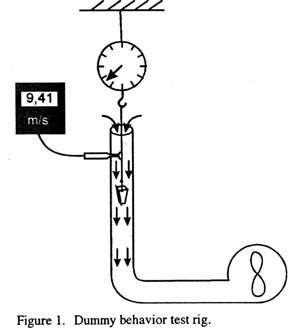
July, 1998, vol.9 no.2
Ulf Hallonborg
Forestry Research Institute of Sweden
Uppsala, Sweden
The author is a researcher in Mechanical Engineering.
ABSTRACT
When a containerized seedling is pneumatically transported through a pipe or hose it occasionally undergoes oscillating movements, referred to as "wobbling", with the container being flung from one side of the hose to the other. Data on this phenomenon obtained in a previous feed-time study were further analyzed. In addition, a laboratory study was carried out in which the behaviours of seedling-container dummies of different sizes and shapes were studied at different air velocities in Plexiglas pipes of various diameters. Both the analyses of the frequencies of wobbling from the previous feed-time study and the results from the laboratory test confirmed that there is covariation between the wobbling tendency of a seedling and the shape of its container. Containers with a large butt-end area tend to wobble more. This leads to differentiation of the seedlings into two groups, seedlings with butt-ended and less butt-ended containers. This differen-tiation was the same whether it was based on feed times from the previous study, frequencies of wobbling from the previous study, or the wobbling behaviour in the recent laboratory test with dummies.
Keywords: Wobbling, pneumatic transport, mechanized planting, seedlings.
INTRODUCTION
When a containerized seedling is pneumatically transported, i.e., when it is blown or sucked through a pipe or hose, it occasionally shows oscillating movements, with the container being flung from one side of the hose to the other. This phenomenon is referred to here as "wobbling". Wobbling tendencies were subjectively observed in a previous study [2]. The number of seedlings subject to wobbling were counted and registered as proportions. In this paper these proportions have been further analyzed and the results compared with those obtained in the feed-time study.
MATERIALS AND METHODS
In the recent laboratory test, the behaviours of the different seedling-container dummies were studied at various air velocities in pipes of different diameters. The wobbling tendencies were observed and the drag force was measured.
Observed frequencies of wobbling
The number of seedlings for which frequencies of wobbling were studied is shown in Table 1.
| Seedling type | Per type | Per growing system |
| Blockplant 121 | 679 | |
| Blockplant 100 | 1184 | 1863 |
| Hiko V50 | 517 | 517 |
| Planta 80 | 2380 | 2380 |
| Plantek 121 | 668 | |
| Plantek 81 | 361 | 1029 |
| Total | 5 789 | 5789 |
First the frequencies of wobbling were analyzed using the PROC FREQ procedure in the SAS package [4]. A 4 x 2 contingency table with four plant-growing systems and wobbling as a binary variable was used. The contingency table was then decomposed to find differences between growing systems. Second, the same procedure was carried out for Blockplant and Plantek, which consist of two seedling types each. This 4 x 2 contingency table was also decomposed to find differences between seedling types.
Laboratory test
Performance
Wooden dummies with the same dimensions as the seedling containers were manufactured. A 12-cm metal hook was fastened to the top of each dummy to simulate some of the stiffness that the green part of the seedling transfers to the container. The metal hook was hinged to a string with a dynamometer inside a Plexiglas pipe (Figure 1) through which the air was sucked using a fan. The air velocity in the center of the pipe was measured with a propeller meter (Schildknecht Miniair 2) inserted from the side. The fan motor speed could be continuously varied to alter the air velocity.
Three pipe diameters were chosen as close as possible to the previously [2] used hose diameters. The pipe diameters used were 40, 50, and 60 mm, while the corresponding hose diameters were 38, 50, and 63 mm.
Dummy shapes are shown in Figure 2, and their measures, weights, and cross-sectional top area are presented in Table 2. The right column gives the observed weight of the containers in the previous feed-time study. In addition to the regular dummies, three supplementary dummy types designed for this test were used. Blockplant 169 was small enough to fit into the 40-mm pipe. Hence Blockplant could be tested in three pipe diameters. A cylindrical equivalent to Hiko was used to emphasize the difference between the streamlined Hiko container and the large butt-end area on the cylinder. For the same reason a straight Plantek 121 was introduced. The butt-end area on the regular Plantek 121 was about one third of the area of the straight dummy. To discern any possible influence of container weight, dummies were made from two different wood species.
The test was performed in series, where the actual dummy was placed in the pipe and the air velocity increased stepwise from zero to the maximum value, which was about 20, 25, and 30 to 35 m/s in the pipes of 60, 50, and 40 mm diameter respectively. After each recorded increase in air velocity the flow was allowed to stabilize for some time, whereafter the air velocity was measured and the dynamometer read. The flow meter took a sample every two seconds in a chosen period of one minute and provided the mean value of the 30 samples. During the sampling period the behaviour of the dummy was studied. Three types of behaviour were recognized:
R = dummy resting or slowly dangling.
W = dummy rattling or slightly wobbling with a distinct frequency.
SW (stands for "super-wobbling") = dummy flutters over the entire pipe
area, striking against the walls.
During super-wobbling the drag force was raised. The dynamometer was equipped with a trailing needle so that the drag force measurements were maximum values, especially during super-wobbling.

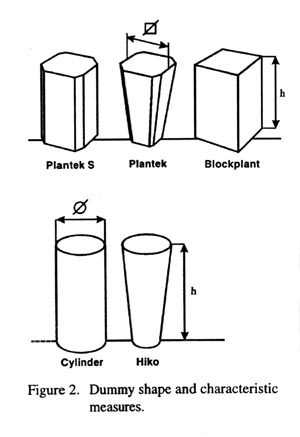
Table 2.Dummy characteristics.
| Seedling type | mm | h mm | Cross sec. area, cm2 | Light dummy | Weight in grams Heavy dummy | Observed mean* |
| Blockplant 169 | 28x28 | 28x28 | 7.7 | 27 | 27 | -- |
| Blockplant 121 | 32x32 | 65 | 10.3 | 35 | 57 | 49 |
| Blockplant 100 | 36x36 | 65 | 12.6 | 41 | 56 | 59 |
| Plantek 121 | 32x32 | 65 | 10.1 | 27 | 40 | 36 |
| Plantek 81 | 38x38 | 65 | 13.8 | 32 | 51 | 64 |
| Plantek S (straight) | 32x32 | 65 | 9.5 | 31 | 49 | -- |
| Hiko | -- | 80 | 7.0 | 32 | 43 | 35 |
| Cylinder | -- | 80 | 8.0 | 39 | -- | -- |
* Weight of container only from feed-time study [2].
If the dummy behaved smoothly, as it often did in the widest pipe, wide air velocity increments were used, and the measuring series was not repeated. For smoothly behaving dummies the measuring series consisted of 20 to 30 measurements. For dummies with high wobbling tendencies, smaller air velocity increments were used and up to five repetitions were made. Such a set of test series consisted of 140 to 160 measurements. Dummies with very high wobbling tendencies could enter into a state of periodic super-wobbling with intermediate periods of less intense wobbling. In those cases drag force readings could be taken several times during the same air velocity measurement.
Since the fan had a serial motor, its speed could be easily varied with an adjustable transformer. The motor's weak characteristic, however, made it almost impossible to adjust the air speed to certain values. Therefore each series of measurements contains unique air-velocity values.
Statistical methods
As mentioned above, no repetitions were made for the same air flow value. Therefore the drag force measurements in a set of series are added to one series, the spread of which includes the effect of repetitions. The gravitational force was subtracted from the gross drag force so that the subsequent calculations dealt with the net drag force induced by the air flow only.
For the light and heavy dummies of each type and identified type of behaviour, a regression line was constructed using the GLM procedure available in the SAS package [1]. The following model was used:
yi = a x vi2 + b + ei
where yi is the drag force, vi is the air speed at observation i, and a and b are regression constants. The residuals ei are assumed to be independent and normally distributed.
As the net drag force would be zero in the absence of an air flow, the constant b should be close to zero for all regression lines. This was the case except for some regressions associated with wobbling or super-wobbling where the lowest air speed is rather high, and the intercept is therefore uncertain. As a consequence, all the intercepts were left out.
The constant for the quadratic term remains as a measure of the increase of the net drag force with increased air speed. When coefficients for the light and the heavy dummy versions were compared, only small, unsystematic differences could be noted. Therefore the measurements for the light and heavy dummies were combined to form one series for each combination of dummy type and pipe diameter. In cases where two or more types of behaviour were identified, the types were analyzed separately.
The total net drag force consists of two parts. One is the pressure drag, which depends on the cross-sectional area A of the actual body and not at all on its shape. It is calculated as:
0.5 x r x v2 x A
where r is air density and v air speed. Its dimension is [kg x m/s2]. The other part is called skin friction and depends on the form and the surface of the actual body [3]. Hence the quotient Cd of the total drag force divided by the pressure drag can be used to describe the influence of the form of the body. In narrow pipes or for large dummies the Cd value is influenced by the raised air velocity around the dummy. Regardless of this, a relative Cd value calculated as the quotient of the coefficients for two seedling behaviours can be used as a measure of differences in drag force. Such a relative Cr value was used to evaluate the difference in drag force between W behaviour and SW behaviour.
RESULTS
Observed frequencies of wobbling
Analysis of the frequencies of wobbling shows that there were differences between plant-growing systems (Figure 3). Seedlings from Blockplant and Plantek systems have a significantly higher tendency to wobble compared with seedlings from Hiko and Planta 80 systems (p ( 0.001). A significant difference was also found between Blockplant and Plantek (p ( 0.001) but not between Hiko and Planta 80 (p = 0.567).
Based on the results, the seedlings can be divided into two categories, those with high wobbling tendencies (Blockplant and Plantek 81 seedlings) and those with low wobbling tendencies (Plantek 121, Hiko and Planta 80 seedlings) (Table 3).
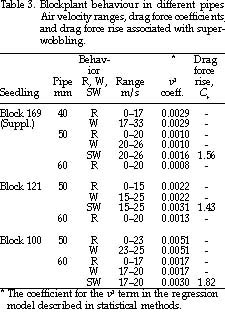
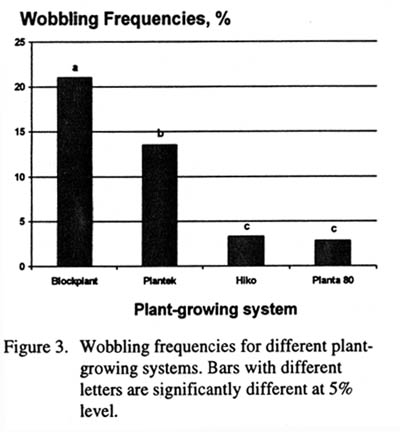
All differences between seedling types were significant (p less than 0.005) except between Blockplant 121 and Plantek 81 (p = 0.398). Differences within plant-growing systems even overrode those between systems (Figure 4). The difference between Plantek 121 and Hiko + Planta 80 was significant, but the difference between Plantek 121 and Hiko seedlings alone was not.
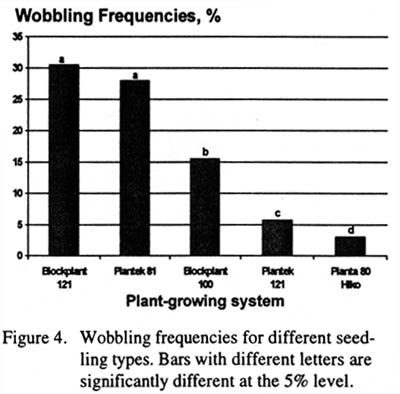
Laboratory test
In this section the behaviour of each dummy type will be described and the regression lines presented. In these descriptions, relative values of the diameters of the pipe and dummy are more important than absolute values. Values below this are expressed as narrow, roomy, or spacious. For each plant-growing system the relation between drag force and air velocity is presented. In cases where SW behaviour was displayed the drag force rise is represented by the shaded area between the W and SW curves.
For each plant-growing system a table gives the air velocity range over which the different behav-iors were observed and the coefficients for the quadratic air-speed term for the corresponding regression line. Where SW behaviour was observed the drag-force rise is also given in the table.
All regression lines had a highly significant coefficient for the quadratic air-speed term (p less than 0.0001). R-square values exceeded 0.90 except in five cases. Three of these involved Plantek 121S in 40- and 50-mm pipes. The lowest value (0.67) applied to SW behaviour in a 40-mm pipe. The other two low values involved Blockplant 121 and 100 in 60-mm pipes.
Blockplant
All the Blockplant seedlings showed the same behaviour, even the supplementary Blockplant 169 (Figure 5). Under narrow conditions, the dummies were clinging to the pipe wall. At high air velocities the dummy could be provoked to wobble but tended to return to rest against the pipe wall. In the narrow 40-mm pipe, drag forces were rather high, but no drag force rise due to SW behaviour was observed. Under roomy conditions, it was easier to provoke W behaviour at increased air speeds. At high air speeds a marked rise in drag force due to SW behaviour was observed. In some cases SW behaviour per-sisted for several minutes. However, sometimes a super-wobbling dummy was suddenly sucked to the pipe wall where it remained quite still, in a stable position, with two corners against the wall. No wobbling was observed under spacious conditions. The drag force rise due to SW behaviour was 40 to 80%.
Plantek
Plantek 121 dummies passed through the R and
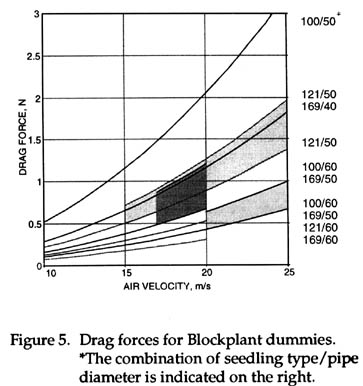
*The combination of seedling type/pipe diameter is indicated on the right.
W behaviours as the air speed was increased. SW behaviour could not be provoked under any of the conditions. The dummy tended to keep to the center of the pipe (Figure 6).
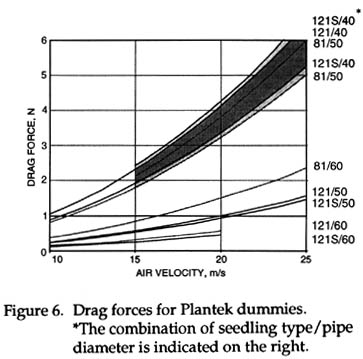
*The combination of seedling type/pipe diameter is indicated on the right.
Plantek 81 dummies also passed through the R and W behaviours, but under narrow conditions the dummies began to display continuous SW behaviour, which was hard to stop. Though the SW behaviour was very evident, the drag force rise was only about 20% (Table 4).
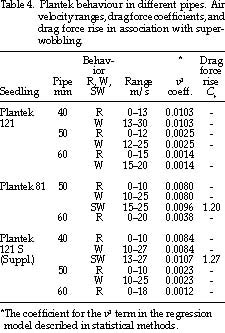
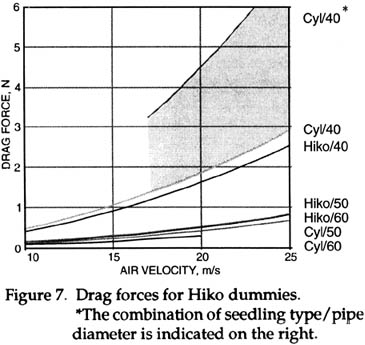
*The combination of seedling type/pipe diameter is indicated on the right.
The supplementary straight dummy, Plantek 121S, began displaying SW behaviour at intermediate air speeds under roomy conditions; under other conditions it behaved like Plantek 121 dummies. The drag force rise due to SW behaviour was 27%.
Hiko
Hiko dummies passed through the R and W behaviours as the air speed was increased. SW behaviour could not be provoked under any of the conditions. The dummy tended to keep to the center of the pipe (Figure 7).
The supplementary cylindrical dummy started displaying chaotic SW behaviour at intermediate air velocities under roomy conditions. The drag force rise due to SW behaviour was 140% (Table 5).
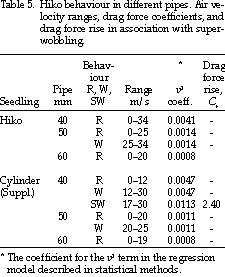
DISCUSSION
The further analysis of frequencies of wobbling for different seedling
types in the previous feed-time study led to a differentiation of the seedling
types similar to that indicated by the results of this feed-time study,
i.e., Blockplant and Plantek 81 constituted one group with high wobbling
tendencies, and Plantek 121, Hiko, and Planta 80, with low wobbling tendencies,
made up the other. Planta 80 had the lowest wobbling tendency, probably
owing to its irregular container shape and rough surface. The growing-tray
cells have fingers but no walls, and the roots are air pruned. These differences
were the reason why Planta 80 was not included in the laboratory test.
The types of dummies that displayed SW behaviour in the laboratory test were the same as those making up the high-wobbling group mentioned above. Moreover, the supplementary dummies, which all had large butt-end areas, displayed super-wobbling. Plantek 121 and Hiko did not show SW behaviour. The drag force coefficients for both groups were found to be proportional to the coeffi-cient of fullness, i.e., the dummy cross-sectional area divided by the cross-sectional area of the pipe (p less than 0.001), but values were almost twice as high for the super-wobbling group, i.e., 0.028 compared with 0.016.
Blockplant dummies with a square cross-section area had a tendency to rest against the pipe wall, probably owing to the air stream in the circular segment between the wall and the dummy. In this position, the dummy remained stable. When the dummy was disturbed it often turned over sidewise and assumed a new stable position. Occasionally, however, it entered into a wobbling or super-wobbling state, seemingly at random, or when disturbed. This state usually ended abruptly as the dummy reverted to its previous resting state.
The supplementary cylindrical dummy tended to be sucked against the wall at low air velocities, but since it did not have any stable position it started to roll against the pipe wall when the air velocity increased. At high air velocities this state changed to wobbling with intervening periods of chaotic super-wobbling. This dummy also showed the highest drag force rise, being almost twice as high as that registered for Blockplant.
The supplementary straight Plantek 121 dummy showed a combination of behaviours, alternately resembling those of the Blockplant and cylindrical dummy, but the drag force rise was not very high.
Even though three lines of experimental evidence all support the same grouping of the seedlings, some possible sources of error should be mentioned. One is, of course, the subjective grading of wobbling. In the previous feed-time study the grading was binary and supported by the sound from the hose. Wobbling was considered to occur when a low frequency sound was heard emanating from the hose. This sound could be clearly heard above the background noise from the fan. In the laboratory test the difference between R and W behaviours was vague, but super-wobbling could be clearly recognized, both visually and audibly. It was also confirmed by a notable drag force rise. Second, conditions under which air velocity measurements were made differed between the previous feed-time study and the laboratory test. In the feed-time test the air velocity was measured in the empty hose, whereas in the laboratory test it was made with a dummy in the pipe. Third, the seedling was transported and the dummy was not. Wobbling in the feed-time study was most frequent in the uphill part of the hose where the transport speed of the seedling was lowest. Finally, the dummy did not have a green seedling. Though it is impossible to tell how all these factors together affect the air speed, it is reasonable to presume that the air speeds were generally higher in the laboratory test. This difference should have been less under roomy and spacious conditions. Though the drag force was often high under narrow conditions, super-wobbling only occurred under more roomy conditions and started at air velocities around 15m/s.
At air velocities used in the feed-time test, the net drag force from the laboratory test was not sufficient to balance the observed weight of the container in that study. This implies that most of the transport force was generated by the green part of the seedling, which also gives rise to frictional forces. Therefore, we cannot exclude the possibility that the transport force under uphill conditions was only barely sufficient.
This raises the question of cause and effect. The results indicate nothing more than that there is a relation between the wobbling phenomena and the shape of the seedling container. It can be argued that seedlings with initially low uphill speeds, caused by high friction, are exposed to a surrounding air velocity high enough to induce wobbling. On the other hand, it can also be argued that wobbling is randomly induced by turbulence around the container butt-end and that the prolonged way would result in long feed times. Wobbling might also cause an increase in friction between the container and the wall.
Wooden dummies were used because they were easy to give a form that lasted through the test and had a suitable density. This choice, however, gives the dummies other elastic properties than that of peat. Plastic deformation of the peat containers was observed during the previous feed-time study, while the wooden dummies in this study were merely bouncing against the pipe wall. The elasticity of the wooden dummies has no significant influence on the inducement of wobbling as this has already started when the dummy hits the pipe wall. The elasticity can prolong the wobbling periods but it is obviously not enough to keep it going as the wobbling can stop abruptly. Therefore the difference in damping property between the peat containers and the wooden dummies is not regarded to have significantly influenced the results of this study.
CONCLUSIONS
Results from the two analyses were found to be in accordance with each other. In both studies, covariation was found between container shape and wobbling tendency. The larger the butt-end of the container the higher was its wobbling tendency. However, the results do not imply the existence of any cause-and-effect relation.
There is covariation between the wobbling tendency of a seedling and the shape of its container. Containers with large butt-end areas enhance wobbling tendencies compared with tapered containers with small butt-end areas. The incidence of wobbling is also related to the space available for the container. Scarce space or much space inhibits wobbling. Having just enough space stimulates wobbling.
A circular, tapered container that fits well into the hose or pipe will have a low incidence of wobbling and give a high drag force.
REFERENCES
[1] [Anonymous]. 1990. SAS/STAT®® User's Guide, Volume 2, version 6, fourth edition. SAS Institute Inc., Cary, NC, USA.
[2] Hallonborg, U. 1997. Feed-time distribution in pneumatic feeding of softwood seedlings [dissertation]. In: Aspects of mechanized tree planting, Acta Universitatis Agriculturae Sueciae, Silvestria 29. Swedish University of Agricultural Sciences, Uppsala, Sweden.
[3] Massey, B.S. 1976. Mechanics of fluids. Van Nostrand Reinhold Company Ltd., pp 297 -306.
[4] Stokes, M.S., C.S. Davis, and G.G. Koch. 1995. Categorical data analysis using the SAS®® System. SAS Institute Inc., Cary, NC, USA.